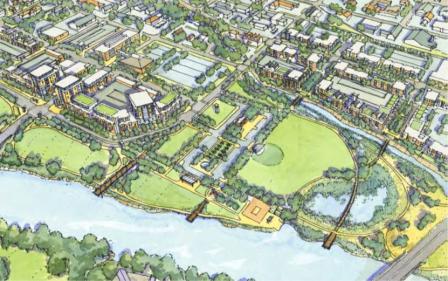Project Summary
Iowa City, Iowa was among the hardest hit communities from the 2008 Iowa River floods with extensive flooding along the riverfront. In 2009, the U.S. Environmental Protection Agency and FEMA worked with the state organization, Rebuild Iowa, to identify policy options to accommodate growth in the Riverfront Crossings District and add green infrastructure and open
space to reduce flooding. Subsequent USEPA assistance on brownfields redevelopment and green infrastructure helped the city develop a master plan to rebuild the riverfront while protecting the environment, promoting equitable development and helping address the challenges of climate change. The Riverfront Crossings Master Plan aims to create a resilient riverfront community park using flood mitigation measures and stormwater best management practices to protect against future flooding.

The plan would entail relocating vulnerable properties and infrastructure away from the floodplain and guiding future development away fromthe most vulnerable areas. The Riverfront Crossings Master P
lan promotes green infrastructure, vegetated buffer zones and public spaces along rivers and streams to reduce flooding, runoff and erosion. While this plan did not explicitly incorporate climate projections, it can help Iowa City better manage projected increases in extreme rainfall, stormwater runoff and flooding along the riverfront. The Riverfront Crossings Master Plan will help Iowa City transition a high risk flood prone area with critical community infrastructure into a public riverfront park that provides recreational amenities, and helps the community adapt to current and future high river flows.


